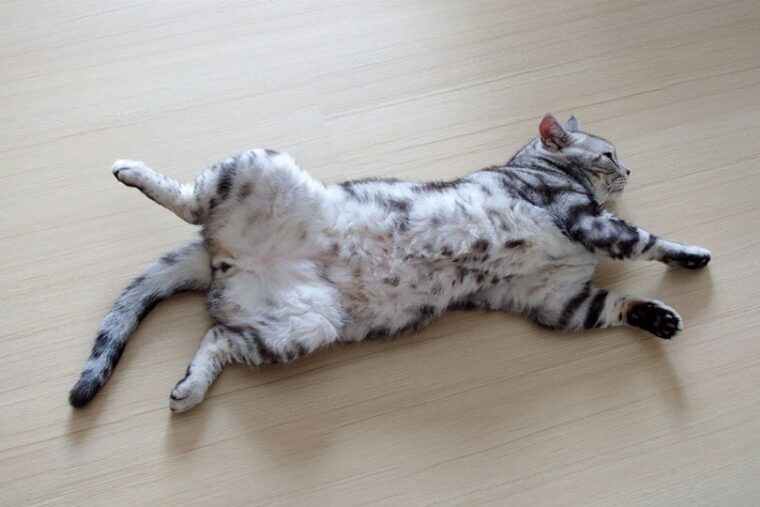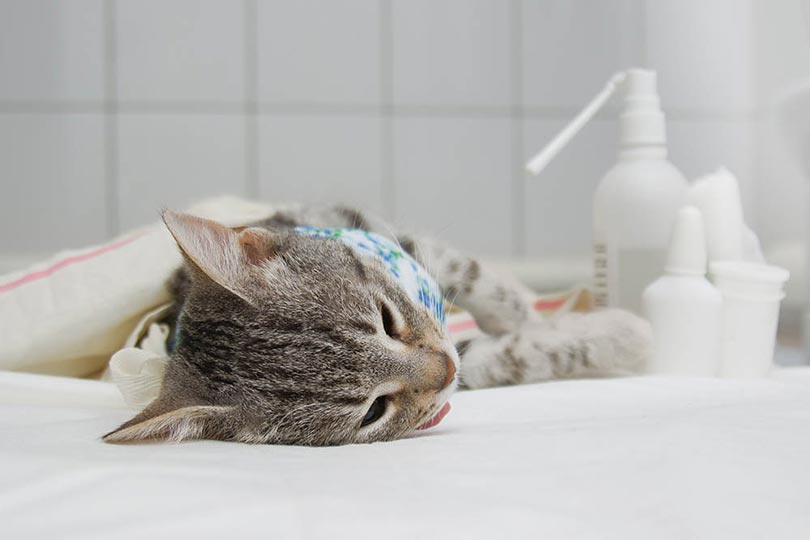
Cryptorchidism is a fairly rare condition in cats. The condition refers to either one or both testicles not descending normally into the scrotum. But what does that mean for your cat? How can you tell if your cat has the condition, and what should you do if you and/or your veterinarian notice it?
In this article we’ll discuss what cryptorchidism is, why it occurs, what risks your cat faces if he is affected, and what you should do if you notice your cat is cryptorchid.

What is Cryptorchidism in Cats?
Cryptorchidism is when one or both testicles do not descend normally into the scrotum. As a cat develops and matures, the testicles actually develop within the abdomen. Normally, there are two testicles, each developing on either side of the abdomen near the kidneys. As development progresses, each testicle makes the long journey through the abdomen, down through what’s called the inguinal canal into the scrotum. If one or both of the testicles don’t complete the journey down to the scrotum, your cat is considered cryptorchid. While this is a rare occurrence in cats, it can happen.
The testicle may be found anywhere abnormal along its journey. It may still be in the abdomen, or it may be just under the skin near the scrotum. Any retained testicle, or a testicle that has not descended into the scrotum normally, is almost always small and abnormally shaped. This can make it difficult sometimes for your veterinarian to find and diagnose.

How Can You Diagnose Feline Cryptorchidism?
The most obvious sign of your cat being cryptorchid is the presence of a scrotum with either one or no testicles inside. This is most easily diagnosed in kittens or young male cats that you know have not been neutered yet.
For Unneutered Kittens
When your kitten goes in for its series of kitten vaccines, your veterinarian should be palpating the scrotum to make sure that both testicles are there. If your veterinarian notices over time that they cannot feel both testicles in the scrotum, they will monitor this as your cat ages. If the testicle(s) still isn’t present by a few months of age, your veterinarian will diagnose your cat as cryptorchid. Your cat should have both testicles within the scrotum no later than six months of age, but typically by 2–4 months of age.
For Adult Cats or Strays
If you have an adult cat or find a stray outside that is older, cryptorchidism may be more difficult to diagnose. Some cats will have a tattoo or a tipped ear if they have been previously neutered by a shelter or rescue group. However, if the cat was once owned and is now a stray, there may be no evidence of a previous neuter. If your veterinarian feels one testicle within the scrotum, that’s a fairly straightforward diagnosis that your cat has not been neutered and one testicle is undescended. However, if your cat does not have any testicles within the scrotum, your veterinarian may have a difficult time with the diagnosis.
If this is the case, your veterinarian may want to send out specialized bloodwork to a laboratory testing for hormonal levels. This may help them determine if your cat is actually cryptorchid. Your veterinarian may also look for what are called penile barbs. These are small spiked structures on the penis of a cat that are only present if there is testosterone, or at least one working testicle. These barbs eventually disappear if a cat has been successfully neutered.
What Are the Causes of Feline Cryptorchidism?
In other species, cryptorchidism is an inheritable condition. This means that one or both parents can pass on a gene or set of genes to cause the abnormality. While this has not been proven in cats, it is strongly suspected due to the prevalence in other species. In addition, because the incidence of cryptorchidism is higher in purebred cats, this more strongly supports this theory as well.
Unfortunately, there are no studies to prove why this occurs in cats. All we can do is extrapolate from other species that it is an inheritable condition.

How Do I Care For a Cat That is Cryptorchid?
Cats who are cryptorchid will act like any other intact (tomcat) male cat. We will use the term “intact” to refer to a male cat that still has one or both testicles present (and has not been neutered). They will often exhibit signs of wanting to look for a mate with behaviors like spraying, marking, and howling. These cats may show more aggression then neutered male cats and may want to escape from the house or yard to mate.
Intact male cats often have a larger, more muscular body shape and can also develop large “jowls” (chubby cheeks/face) as compared to neutered cats. Intact male cats also have a very distinct odor to their urine. It can be described as very pungent and “ammonia-like”. Some people will get watery eyes and/or start to sneeze around the smell of tomcat urine.
As a cryptorhid cat ages, he may develop abnormalities related to the retained testicle, such as cancer. This may not be visible immediately and may take time to diagnose by your veterinarian.
What to Do
If your cat is cryptorchid, the first thing you want to do is schedule an exam and neuter with your veterinarian. It’s been proven in other species that cryptorchidism is a disease that can be transmitted to offspring, so we do not want these animals breeding if possible. Depending on if your cat has either one or both testicles that are undescended will help your veterinarian determine how extensive surgery may be and discuss the details about the procedure with you. Unfortunately, a cryptorchid neuter is not as straightforward as a regular neuter, and your veterinarian will discuss the aftercare and cost with you.
Aside from neutering your cat, caring for them is similar to any other cat. Because they may show signs of aggression towards other cats and be looking for a mate, we recommend keeping any intact male inside and away from other cats. Also be careful when opening the door and/or windows of the house, as intact males often try to escape the house looking for a female.


Frequently Asked Questions (FAQs)
How common is cryptorchidism in a cat?
Cryptorchidism in a cat is much less common than in dogs. In cats, the percentage of the affected population that are cryptorchid are approximately 1.3–1.9% in one study, and in another study 0.37–1.7%. Of these, it’s reported that about up to 88.7% and as low as 62% of affected cats have unilateral cryptorchidism, or only one testicle undescended.
Does my purebred cat have a lower chance of being cryptorchid?
No, purebred cats actually have a higher incidence of cryptorchidism than mixed breeds. In one recent study, the percentage of cryptorchid purebred cats was 6.2%. However, the incidence of purebred cats in this same study was only about 10.5%, so the sampling pool was very small.
Will my cat die if he’s cryptorchid?
Being cryptorchid is not an immediate death sentence. These cats will act very similar to any other intact male cat. However, because they are intact, they may have a higher incidence of getting into fights with other males and/or escaping the house and suffering trauma. As a cat with cryptorchidism ages, they can develop testicular cancers. Depending on if and when this occurs, and what type of cancer develops, this may significantly affect your cat’s quality of life and lifespan.


Conclusion
Cryptorchidism is a rare condition in cats in which one or both testicles do not descend correctly into the scrotum. The abnormality is typically only one testicle, and is more common in purebreds. In other species, this has been found to be a heritable link.
Even though no such definitive link has been found in cats, the recommendation is to neuter the affected cat(s). Not only will these cats still exhibit intact male cat behavior, but they may be more prone to developing testicular cancers as they age. Your veterinarian should be able to help you navigate the specifics of surgery of your cryptorchid cat.
Featured Image Credit: Iryna Mylinska, Shutterstock






